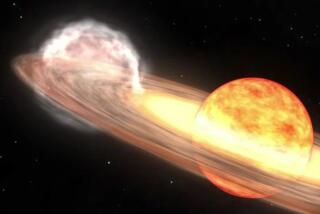Night Sky Over Bethlehem Still Beckoning Stargazers
- Share via
Consider it an astronomical time machine.
Thanks to the magic of physics and mathematics, the Griffith Observatory--in its “Christmas Star”’ show--has used the Zeiss planetarium star projector to create an image of what the night sky was like in 3 or 2 BC.
It was about then that three men--tradition names them as Gaspar, Balthazar and Melchior--followed a star in search of a newborn king. They have been called wise men, kings and Magi, but they have also been described as astrologers who believed that gods used the configurations of the planets to influence events on Earth.
Their visit to the infant Jesus is recorded in the Gospel of Matthew, at the beginning of Chapter 2.
Modern astronomers have wondered which star the three men followed.
“Basically, we use math to figure out where the planets were in 2 and 3 BC.,” said observatory astronomical lecturer Patrick So, describing the detective work based on the laws of gravitation and motion.
They also use ancient records. “Astronomical events are good timekeepers,” So said.
Astronomers can’t pin down the identity of the star because no one knows exactly when Jesus was born. But there were some pretty rare astronomical events going on at that time that could have produced the famed “Star of Bethlehem.”
“How they interpreted it was the important thing,” So said.
The show at the planetarium, 2800 E. Observatory Road, runs through Jan. 3. Times are 1:30, 3, 4:30 and 7:30 p.m. daily. Today, only the first two shows are scheduled because it’s Christmas Eve and the observatory closes at 4. The observatory is closed Christmas Day.
Admission is $3.50 for adults, $2.50 for senior citizens, and $2 for children ages 5 to 12. Children under 5 are admitted free with a paying adult but can only attend the 1:30 p.m. show.
More to Read
Sign up for Essential California
The most important California stories and recommendations in your inbox every morning.
You may occasionally receive promotional content from the Los Angeles Times.













